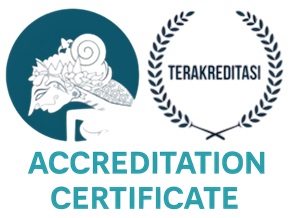Pembuatan VCO (Virgin Coconut Oil) Dengan Penambahan Ekstrak Jeruk Nipis (Citrus aurantifolia swingle), Bawang Putih (Allium Sativum), dan Ragi Tape (Saccharomyces Cerevisiae) Secara Fermentasi dan Pengasaman
Abstract
The manufacture of Virgin Coconut Oil (VCO) which is done by heating is considered less effective because the quality of VCO produced is not good and also requires expensive production costs. Virgin Coconut Oil (VCO) is a processed product from coconut that has many benefits if processed properly, which is one of the reasons VCO has a promising target market, so further research needs to be done on the process of making VCO so that it can produce quality products. This study aims to determine the effect of the addition of garlic extract (Allium sativum), lime (Citrus aurantifolia swingle), and yeast tape (Saccharomyces cerevisiae) on Virgin Coconut Oil (VCO) products and to know the process of making VCO simply by fermentation and acidification to save production costs. Fermentation is the process of making VCO using the help of bacteria, in this study used Saccharomyces cerevisiae, while the manufacture of VCO by acidification is the manufacture of VCO with the addition of acidic substances, in this study used lime. The processing of VCO by fermentation or acidification in this study does not go through a stirring process, but is allowed to stand for 8-10 hours until three layers are formed, namely water, oil, and blondo which will then be separated to obtain the desired product (VCO). The addition of garlic extract in the process of making VCO by fermentation is thought to be able to eliminate the rancid odor in the resulting product, this is proven to be true after the results obtained from the VCO manufacturing process show that VCO given the addition of garlic extract does not smell rancid but a little smell of garlic mixed with delicious savory coconut. Overall, making VCO by fermentation using tape yeast, adding garlic extract, and acidification using lime produces VCO products that are clear in color and do not smell rancid so that the results of VCO can be categorized as good. In addition to the conventional process that is often done, making VCO can also be done by fermentation and acidification as done by researchers. In the process of making VCO by acidification, researchers need to ensure that the pH is in an appropriate state.
Downloads
Copyright (c) 2023 Nabilah Natalia Shafinka

This work is licensed under a Creative Commons Attribution-ShareAlike 4.0 International License.











